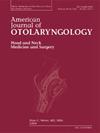肉芽肿合并多血管炎患者听力损失的危险因素探讨:一项单中心回顾性研究
IF 1.7
4区 医学
Q2 OTORHINOLARYNGOLOGY
引用次数: 0
摘要
肉芽肿病合并多血管炎(GPA)通常会影响耳朵,导致不可逆的听力损失,影响患者的生活质量。本研究旨在探讨和总结GPA患者听力损失的相关危险因素,为早期诊断和改善预后提供价值。材料与方法收集2013 - 2023年在该中心住院的患者资料,听力正常患者19例,听力障碍患者89例,再分为4组。收集了基本特征、实验室检查、临床表现和治疗方法的信息。首先进行单因素分析进行变量选择,然后进行多因素分析进一步验证所选择的因素是否为导致听力损害的危险因素,并进行进一步探讨。结果在不同的听力损失亚组中,年龄、p-ANCA水平、耳受累、眼受累和并发面瘫显著加重了听力损失水平。相反,蛋白酶3抗中性粒细胞胞质抗体(PR3-ANCA)水平、利妥昔单抗(RTX)治疗与听力损失水平呈负相关。通过多因素分析,年龄、耳朵受累、眼睛受累和面瘫被确定为更严重听力损失的危险因素。此外,我们分析了不同严重程度组中听力损失类型的分布,发现听力损失越严重,感觉神经性听力损失的比例越高。结论本研究发现年龄、耳受累、眼受累和面瘫是导致肉芽肿病合并多血管炎(GPA)患者不可逆听力损失的四个因素。GPA患者听力损失的发生呈现由传导性听力损失向感音神经性听力损失的发展过程,提示GPA患者听力损失背后的一些机制。本文章由计算机程序翻译,如有差异,请以英文原文为准。
Exploration of risk factors affecting hearing loss in patients with granulomatosis with polyangiitis: A single-center retrospective study
Introduction
Granulomatosis with polyangiitis (GPA) commonly affects the ears, leading to irreversible hearing loss and impacting patients' quality of life. This study aims to explore and summarize the risk factors associated with hearing loss in GPA patients, providing value for early diagnosis and improved prognosis.
Materials and methods
We collected information from patients during their hospitalization at this center from 2013 to 2023, including 19 patients with normal hearing and 89 patients with hearing impairment which is divided into four groups furtherly. Information on basic characteristics, laboratory tests, clinical manifestations, and treatment methods was collected. Initial univariate analysis was conducted for variable selection, followed by multivariate analysis to further verify if the selected factors are risk factors causing hearing impairment and to explore further.
Results
In different subgroups of hearing loss, it was found that age, levels of p-ANCA, ear involvement, eye involvement, and concurrent facial paralysis significantly exacerbate the level of hearing loss. Conversely, the levels of proteinase 3 anti-neutrophil cytoplasmic antibodies (PR3-ANCA), treatment with rituximab (RTX), and the level of hearing loss are negatively correlated. Through multifactor analysis, age, ear involvement, eye involvement, and facial palsy were identified as risk factors for more severe hearing loss. Furthermore, we analyzed the distribution of types of hearing loss in different severity groups and observed that the more severe the hearing loss, the higher the proportion of sensorineural hearing loss.
Conclusion
This study found that age, ear involvement, eye involvement, and facial palsy are four factors that contribute to irreversible hearing loss in patients with granulomatosis with polyangiitis (GPA). The occurrence of hearing loss in GPA patients appears to progress from conductive hearing loss to sensorineural hearing loss, indicating some mechanisms behind the hearing loss in GPA patients.
求助全文
通过发布文献求助,成功后即可免费获取论文全文。
去求助
来源期刊

American Journal of Otolaryngology
医学-耳鼻喉科学
CiteScore
4.40
自引率
4.00%
发文量
378
审稿时长
41 days
期刊介绍:
Be fully informed about developments in otology, neurotology, audiology, rhinology, allergy, laryngology, speech science, bronchoesophagology, facial plastic surgery, and head and neck surgery. Featured sections include original contributions, grand rounds, current reviews, case reports and socioeconomics.
 求助内容:
求助内容: 应助结果提醒方式:
应助结果提醒方式:


